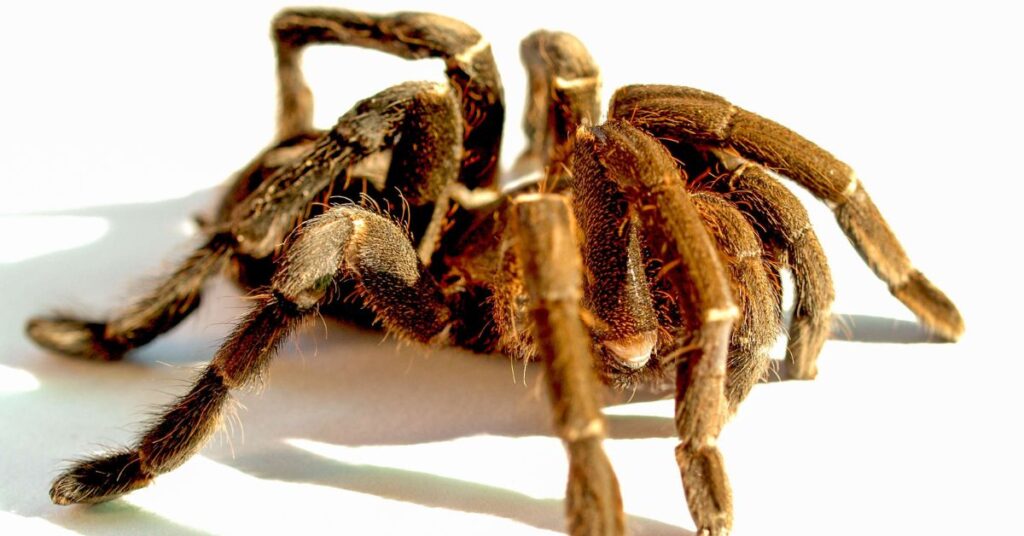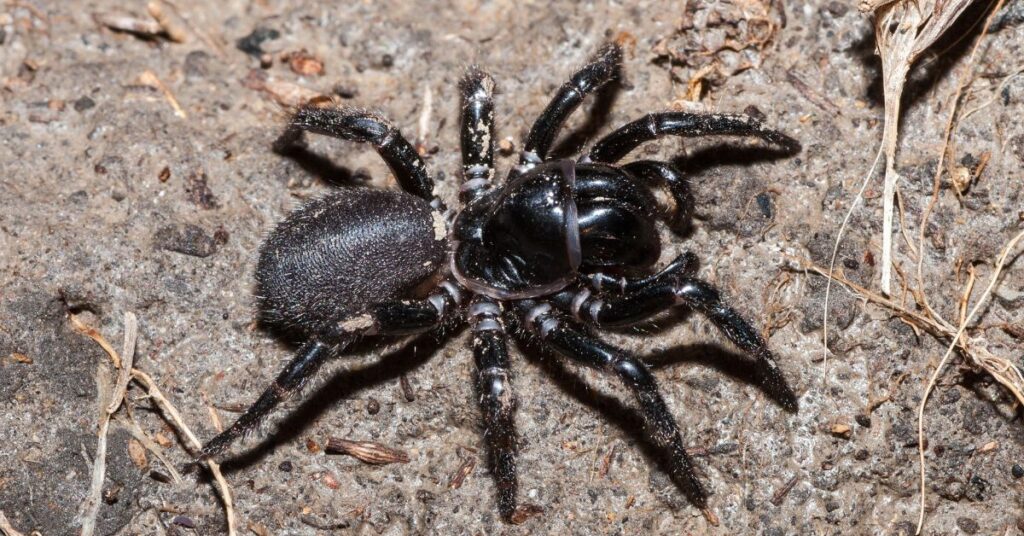
The Goliath Bird-Eating tarantula (Theraphosa Blondi) is the largest spider in the world, with a body size that can reach up to 4 inches (10 centimetres) in length and a leg span that can stretch up to a foot (30 centimetres) or more so let’s have a closer look at this incredible creature.
How Big is the Goliath Birdeater?
The Goliath Birdeater truly is a sight to behold. As previously mentioned, it a HUGE spider, the largest in the world in fact.
It’s body size alone can reach 5 inches, but together with its leg span it can reach up to a foot in length, while its fangs are 2–4 cm or 0.79–1.57 in., with females maturing in 3–6 years and having an average lifespan of 15 to 25 years.
As with most tarantulas, males die soon after maturity and have a lifespan of three to six years.
However, unlike other species of spider/tarantula, females do not eat the males during mating. After mating, the female will lay 100 to 200 eggs, which hatch into spiderlings within 6–8 weeks.
Birdeaters are one of the few tarantula species that lack tibial spurs, located on the first pair of legs of most adult males.
The Goliath is coloured brown or black and has a furry texture, almost silky to the touch and as most arachnids, has eight eyes.
Habitat and Distribution
The Goliath Spider is found in the rainforests of Central and South America and tends to live in burrows in the ground but can be commonly found in marshy or swampy areas. It is a nocturnal species.
The Goliath Birdeater prefers areas with high humidity and temperatures and can be found in countries such as Brazil, Guyana, and Venezuela.
Hunting and Diet
The Goliath hunts in a similar manner to most tarantulas, in that it senses the vibrations of nearby prey with its sensitive hairs then pounces with lightning-fast speed using it’s large, sharp fangs to inject its venom.
As well as insects and small animals (rodents, frogs, lizards, snakes), the Goliath birdeater will also eat other spiders.
Role in the Ecosystem
Despite its fearsome appearance, the Goliath Spider is actually an important part of the rainforest ecosystem.
It helps to control the populations of insects and other small animals, keeping the delicate balance of the rainforest intact.
How Dangerous is the Goliath spider?
Although the Goliath Spider is known to be aggressive, large and intimidating, it’s actually quite harmless to humans.
Its venom is not potent enough to cause any serious harm, although its bite can be painful.
In fact, the spider is more afraid of humans than we are of it and will often try to avoid confrontation if possible.
What happens if you get bit by a Goliath spider?
If you do happen to get bitten by a Goliath Spider, you may experience some pain and swelling at the site of the bite.
However, there have been no reports of serious or life-threatening reactions to the spider’s venom.
What is the Deadliest Spider in the World?
According to the Guinness World Records, the Sydney funnel-web spider, Atrax robustus, is the most dangerous spider to humans in the world. Native to Australia, this poisonous spider is found in moist habitats such as under logs or in gardens.
We have an article dedicated to the funnel-web spider here.

Are there Goliath spiders in the UK?
No, the Goliath Spider is not found in the UK. It’s only found in the rainforests of Central and South America.
The only Goliath birdeaters in the UK are kept as pets.
Keeping a Goliath Spider as a Pet
Food and Feeding
Whilst it seems obvious to feed these creatures lots of live mice, we suggest feeding the Goliath Bird-eating Spider a diverse diet consisting of grasshoppers, Tenebrio larvae, adult crickets, and only occasional feedings (once or twice a month maximum) of mice. This variety more closely mirrors the diet of this tarantula in nature and will keep them healthy.
Housing
The Goliath Bird-eating Spider should always be kept in a large enclosure. Use at least a 30-gallon terrarium or the largest plastic sweater box. A substrate of peat moss or cypress mulch works well.
A large shelter should be offered in the form of a cork bark “cave” or a half-buried clay pot.
Though they are found in humid tropical forest areas, in captivity it is best to maintain them on the dry side and spray them once or twice a week.
A large diameter flat dish with fresh water should be available at all times.
Temperature and humidity requirements:
This species can be maintained at about at 78° to 82° F with a moderate humidity level.
Cage Care
As with all tarantulas, a good habit to get into is cleaning up any uneaten prey items the day after feeding your tarantula.
Decaying organic matter commonly attracts mites, fungus, mold and other potentially harmful organisms into the enclosure.
If your pet has recently molted, remove uneaten prey items immediately. Newly molted tarantulas are vulnerable until their exoskeletons and fangs have hardened.
Behaviour in Captivity
The Goliath Bird-eating Spiders are very aggressive and best housed singly. They are quick and nervous.
They make a hissing noise if they feel threatened by rubbing the bristles on their legs. They will also rear up to fling their abdominal hairs and will try to bite when stressed.
Handling
As previously mentioned, the Goliath is aggressive and defensive. It is possible to handle one, with EXTREME caution, but be aware that its urticating hairs are some of the most irritating of all spiders and its bite can cause damage from the size of the fangs.
Availability
The Goliath Bird-eating Spider has been bred in captivity and is sporadically available as spiderlings. Unfortunately, many “collectors” have single specimens. Healthy females and mature males often do not get together in a timely manner.
Several breedings have occurred in Europe and there is no doubt that in the early days many wild-caught specimens dropped egg sacs that were successfully hatched. As with many rare species, hopefully the future will see the production of many healthy spiderlings for the hobby.
The Goliath Spider is a fascinating creature that deserves our attention and appreciation. Although it’s the largest spider in the world, and should be treated with severe caution, it’s actually quite harmless to humans. By learning more about the Goliath Spider, we can gain a greater understanding and appreciation for the diverse and complex web of life that exists in our rainforests.
Until next time, stay spidery!
